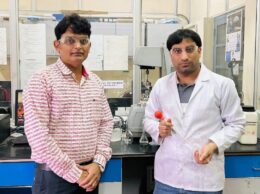Gandhinagar: With an aim to boost scientific, multidisciplinary, fact-based approach to advance research in archaeological sciences, the Ministry of Culture, Government of India (GoI), and Archaeological Survey of India (ASI) have established the ‘ASI Archaeology Chair’ at the Archaeological Sciences Centre of the Indian Institute of Technology Gandhinagar (IITGN). The Chair was inaugurated today along with a three-day International Colloquium on “Emerging Perspectives of Harappan Civilisation” by Shri Govind Mohan, Secretary, Ministry of Culture, GoI, as the Chief Guest; Dr Alok Tripathi, Additional Director General, ASI; and Prof Rajat Moona, Director, IITGN.
Apart from promoting research in various aspects of archaeology through various collaborative and scholarly activities, the resources under this Chair will also be used to deepen research in multiple facets of the ancient Harappan / Indus / Sindhu-Saraswati Civilisation. With state-of-the-art research facilities and an extraordinary pool of researchers from all over the world, it will create a stream of work to help unearth several new facets through an amalgamation of fieldwork on the ground and scientific research on the subjects.
Speaking on the occasion, Shri Govind Mohan, Secretary, Ministry of Culture, GoI, and Chief Guest of the event, said, “The work that we are starting today is of great significance for the country from a cultural perspective. Vedas are the oldest known works of human expression, and they also speak of a civilisation which was hugely advanced and evolved in various aspects, including women empowerment, respect for environment, human ethos. On the other hand, we have remnants of the Sindhu-Saraswati Civilisation, whose urban planning and architecture, drainage system, trade routes etc were so marvellous that many advanced civilisations of today would be envious of them. So we need to delve deeper to find if there is any commonality or connection between these two spaces. And I am sure that this colloquium and the Chair will help find answers to these questions in a scientific way by using state-of-the-art archaeological techniques. We will continue to work deeply with IITGN in order to uncover a lot of new paradigms and facts to help us understand fundamental questions for ourselves like who we are, where have we come from, and how have we evolved.”
Dr Alok Tripathi, Additional Director General, ASI, recalled the groundbreaking work by late Daya Ram Sahni, a veteran Indian archaeologist who led the discovery of the Harappan Civilisation in the 1920s, and termed this conference and Chair at IITGN as a new chapter to find out more about Indian culture, history, civilisation, and its relation with the Vedic culture. Prof Rajat Moona, Director, IITGN, expressed gratitude that the Ministry of Culture and Archaeological Survey of India have supported this conference and Chair at IITGN that will help us find answers to several unexplored facets of the Harappan Civilisation with coordination between research institutions and government organisations.
Prof Michel Danino and Prof VN Prabhakar from the Archaeological Sciences Centre of IITGN introduced participants to the work of the Centre and objectives of the Chair. Prof Sharada CV presented the vote of thanks.
As a part of the three-day International Colloquium on “Emerging Perspectives of the Harappan Civilisation”, being organised in collaboration with the Ministry of Culture and the Indira Gandhi National Centre for the Arts (IGNCA), Prof Ajithprasad, Maharaja Sayajirao University of Baroda, and an erudite scholar of archaeology, gave a keynote address on the topic “Harappan Civilisation: Perspectives from Gujarat”. He gave a broad panorama of the Harappan / Indus-Saraswati Civilisation, starting from its antecedents in different regions of the North-West of the Indian subcontinent and explained the accomplishments of this civilisation, including their technological and administrative aspects. He also discussed the possible factors in its decline, including climate change towards the end of the third millennium BCE.
During the course of the next two days, more than 50 archaeologists, scientists, and research scholars from India and abroad are going to speak and present their research on the Harappan Civilisation during different thematic sessions, including Genesis of the Harappan / Indus / Indus-Saraswati Civilisation, terminologies; State and polity during the Harappan Civilisation; Trade contacts with other regions; Technology during the Harappan Civilisation; Climate and environmental studies; Bio-archaeological perspectives (floral, faunal, and other related studies); Bio-anthropological / DNA studies and the composition of the Harappan population; The Indus script: inputs from archaeology and statistical studies; De-urbanisation processes of the Harappan Civilisation; Harappan Civilisation vs Vedic Culture: possible points of contact/transmission; among others. Another 15 research scholars will be presenting their work in posters. The colloquium will keep ample time for discussions on the way forward for future research.









